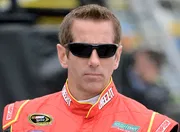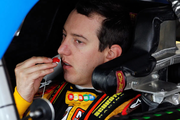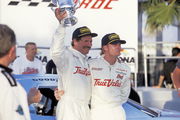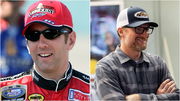
Imago
NASCAR, Motorsport, USA Cup Practice & Qualifying Aug 12, 2023 Speedway, Indiana, USA NASCAR Cup Series driver Shane Van Gisbergen 91 during practice for the Verizon 200 at the Brickyard at Indianapolis Motor Speedway Road Course. Speedway Indianapolis Motor Speedway Road Course Indiana USA, EDITORIAL USE ONLY PUBLICATIONxINxGERxSUIxAUTxONLY Copyright: xMikexDinovox 20230812_mcd_ad4_24 | Image Credits: Imago

Imago
NASCAR, Motorsport, USA Cup Practice & Qualifying Aug 12, 2023 Speedway, Indiana, USA NASCAR Cup Series driver Shane Van Gisbergen 91 during practice for the Verizon 200 at the Brickyard at Indianapolis Motor Speedway Road Course. Speedway Indianapolis Motor Speedway Road Course Indiana USA, EDITORIAL USE ONLY PUBLICATIONxINxGERxSUIxAUTxONLY Copyright: xMikexDinovox 20230812_mcd_ad4_24 | Image Credits: Imago
With the introduction of the Next-Gen cars in the NASCAR arena, a lot has changed in terms of design, specs, and controls. Drivers these days have learned to drive in cars with automatic transmissions and, hence, have adjusted themselves to modernized controls. However, some drivers are accustomed to driving cars the old-fashioned way. Indeed, there are pros and cons to both. As the debut Indy race of Kiwi star Shane Van Gisbergen approached, the Supercar sensation found himself in a fix.
Watch What’s Trending Now!
Although the No. 97 Chevy has been trying to learn and cope with the changes, one of these changes has stood out and is now a frequently discussed topic in the NASCAR community.
ADVERTISEMENT
The recent obsession with his toes is too much for Shane Van Gisbergen
Shane Van Gisbergen hails from a Supercar background. In their cars, the left foot is always used to change gears and the right foot to brake. However, Shane noticed that the cars in NASCAR require the left foot on the brake. It was then that he used the age-old heel-and-toe technique. Since then, everyone seems to be talking about his skills.
SVG has been doing it forever, so he does not find anything special about it. He admitted, “I always right-foot break and hell-toe. It’s what I’ve grown up doing. I only started left-foot braking last year in a rally car. So yeah, to me it’s normal, but I guess they don’t do it here anymore…”
ADVERTISEMENT
ADVERTISEMENT
When you are driving a car at a speed as fast as nearly 200 mph, making turns is tricky. The perfect balance between braking, clutching, and accelerating is absolutely crucial. A minor mistake might result in a huge crash and even endanger the life of the driver.
Watch this story: How Shane Van Gisbergen?s Chicago Victory Became an Embarrassing Nightmare for Cup Drivers?
Hence, this technique was absolutely essential back in the day. Heel-and-toe helped smoothen the downshifts while making a turn. So, as the lower gear is engaged, the car can be in its optimal rev range, meaning smoother and quicker acceleration out of the corner.
ADVERTISEMENT
Top Stories
Another Almost Fatal Disaster Surfaces From Statesville Airport Amidst Ongoing Greg Biffle’s Crash Investigation

The Retirement Question – What Happens if Kyle Busch Fails in 2026?

What Is NASCAR’s 5-Strike Rule That Could Change Its Future? Check All Details Here

When NASCAR Didn’t Wait: Dale Earnhardt’s Injury Comeback Came With the Hot Seat of Zero Sympathy

Dale Jr’s CARS Tour’s Powerful Greg Biffle Tribute Has NASCAR Fans Making One Emotional Demand

Paul Morris does not approve of left-foot braking
About four years ago, veteran racer Paul Morris put out a video showing how different today’s in-car mechanisms were from the ones he once drove.
Paul “The Dude” Morris, being an old-school driver, learned to drive with his right foot on the brake and his left foot on the accelerator. This way, he found his left foot closer to the footrest inside the car. He explained that while making a turn, he could find his body more stable with that setting. Of course, a driver would still have his seatbelt fastened, but still, the swerve in the body while making a turn cannot be totally nullified.
ADVERTISEMENT
He said, “In my day, it was all about manuals. When you learn to drive the manual you tend to always use your right foot for braking because your left foot is obviously changing gears. But, with an automatic nowadays, it amazes me that a lot of drivers are actually using their left foot to brake.”
Shane is one of those drivers who is forced to use his left foot on the brake. However, he has the heel and toe to his rescue. Now the biggest question is, will it work out for him in today’s race? Only time will tell.
Read more: ?Just Tryna Be Skinny? ? Shane Van Gisbergen Reveals His Tactics As He Copes With NASCAR?s Intensity
ADVERTISEMENT
ADVERTISEMENT
ADVERTISEMENT
ADVERTISEMENT

